
September 11, 2017
By Ola Lisowski
MacIver Institute Research Associate
As children all across Wisconsin head back to school, it is time for the MacIver Institute’s annual examination of our educational system. To make sure we’re all set for the semester, let’s take a look at what’s going on with our students.
First, we’ll touch on recent developments at the State Capitol, followed by a rundown of how our kids are doing on a slew of exams and other metrics. We’ll also examine different indicators of a healthy educational ecosystem – such as the state of school choice and how the state is addressing failing schools – before wrapping up. Let’s start off with an update on the 2017-19 Wisconsin State Budget.
A Busy Budget Summer
To understand the context of Wisconsin’s state of education, we have to start with the 2017-19 biennial budget. We’ve been covering those issues from the fourth floor of the Capitol all summer long.
The state’s Joint Committee on Finance (JFC) agreed to a budget plan for K-12 schools that sends $693.3 million more to the Department of Public Instruction (DPI) over current funding levels. JFC’s plan sends $8.9 million less than Gov. Scott Walker proposed in February, but the increase is still considerable.
Included in the budget: more funding for schools across the board in the form of per pupil categorical aid payments, more flexibility to raise property taxes for low-revenue school districts, and more access to choice and charter schools statewide. Changes to the Special Needs Scholarship Program will allow approximately 250 more students to participate, effectively doubling the program.
After three years of changing students’ standardized tests three different times, Wisconsin is stuck with the Forward Exam. That’s a clear win for students and the rest of the public, as we’ll soon have another yardstick to compare student growth year over year.
Add to that a one-year waiver for the Opportunity Schools Partnership Program (remember that name?) and Racine public schools, plus $9 million for a laptop for every high school freshman. A mixed bag? We thought so, too.
In a first for the administration, Walker’s budget plan for the Department of Public Instruction wasn’t totally far off from DPI’s own request. State Superintendent Tony Evers’ plan would send more money through the general aids formula rather than categorical aids outside of normal spending limits. However, with increased spending in realms like mental health and rural teacher training, Evers spent much of the summer praising Walker’s investments.
Read more about the K-12 biennial budget right here.
The Metrics: How Are Our Students Performing?
DPI is slated to release new student report cards some time at the end of October or the beginning of November. Those report cards will show new results for the Forward Exam, updated graduation rates, and plenty of other metrics. For now, let’s run through our most current numbers to get a sense of where our students are.
ACT Scores
Just last week, the ACT released a new national report that details scores across the country for the class of 2017.
Wisconsin’s class of 2017 scored an average of 20.5 points out of 36 on the ACT – the exact same score achieved by our 2016 students. Wisconsin’s score is below the national average of 21.0 points, which rose slightly from an average score of 20.8 in 2016. It must be noted, however, that all of our students take the ACT in Wisconsin. In other states, only the more accomplished students take the test, which translates into a higher average score.
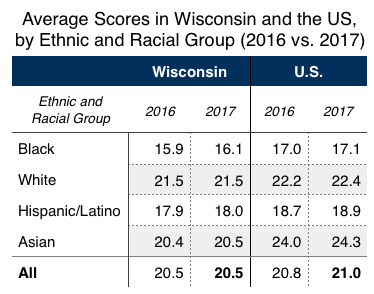
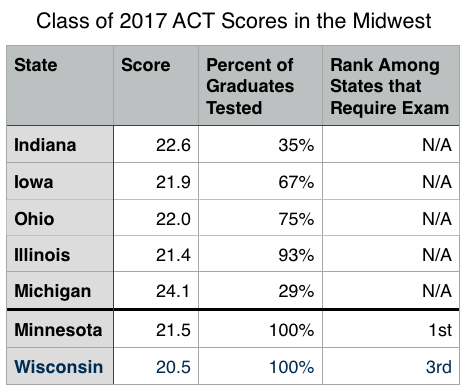
The state of Wisconsin began administering ACT exams to all high school juniors in 2015. Since then, we’ve seen a fall in ACT scores. But dips in scores when a large increase in participation occurs is usually to be expected. Whether students plan to move on to college, getting a sense of their achievement levels is always a good thing.
Seventeen states test all students. Of those, Wisconsin’s composite score of 20.5 was the third highest behind Minnesota (21.1) and Colorado (20.8). Illinois recently stopped testing all of its students, but at 93 percent participation, students there scored an average of 21.4.
Many Wisconsinites may find it surprising that we trail Illinois. More Illinoisans reached ACT College Readiness Benchmarks in every subject than Wisconsinites. Those ACT College Benchmarks are set to test readiness for higher education among exam takers.
In fact, just 25 percent of the 2017 Wisconsin graduates met all four ACT College Readiness Benchmarks, according to the report. Students stayed at exactly the same levels as last year, too, revealing a plateau in growth.
The data released also reveals a small gain in closing the achievement gap among ethnic and racial minority groups – a good sign for Wisconsin’s persistent achievement gap.
Students in almost every ethnic group posted score gains compared to last year, especially among historically underserved populations. However, white students stayed at the same score, and native Hawaiian/Pacific Islander students decreased their average score from 19.4 to 18.4 points.
Earlier in the summer, Wisconsin’s own DPI also released a new dataset examining the class of 2016. Overall, that class marked a stark increase in ACT participation – 45 percent more students took the exam than the year before.

Milwaukee Public Schools (MPS) students, in particular, posted strong rates of ACT participation, with a greater percentage of Milwaukee students taking the exam than the statewide average.
Still, the score indicates that Wisconsin students are falling behind. This was also clear in results for the ACT Aspire, which tests college readiness and is administered to high school freshmen and sophomores. On that exam, 60 percent of students earned scores of “exceeding” or “ready” in English, and 38.9 percent of students achieved the same level in math. As we’ve known, our students and our schools have major work to do. This release only underscores that fact.

Students in Milwaukee Public Schools had lower levels of college readiness than the state average on the ACT Aspire, with just 10 percent of MPS students showing readiness in math and just 31.7 percent showing readiness in English.
Back in the statehouse, the state budget that is expected to pass soon does include some provisions to address the problem of kids trapped in persistent failing schools. Performance-based funding rewarding Milwaukee’s best-performing schools was stripped from Walker’s budget by the Joint Finance Committee. Instead, the JFC decided to send extra funding to just failing schools, and the MPS will see new investments in MPS summer school initiatives to help children who need extra catch-up help.
Graduation Rates
Every spring, the Department of Public Instruction (DPI), headed by State Superintendent Tony Evers, releases high school graduation rates for the prior year. The release of the graduation rate data this year has been delayed for months with no real explanation from the department. When the new information was finally released in August, DPI published it with a small asterisk. Apparently, DPI published incorrect grad rates for some high schools in Wisconsin, which brings into question the overall accuracy of DPI’s rates. So, while we try to sort out what happened, our analysis of high school graduation rates comes with a small asterisk.
According to DPI, in 2016, 88.2 percent of students graduated high school in four years. That number was down a hair from the prior year’s 88.4 percent.

Assuming the true rate is still in a similar range, Wisconsin students have one of the best four-year graduation rates in the country. The nationwide average was 83.2 percent in 2015, according to the U.S. Department of Education. Wisconsin posted the second-highest scores after Iowa, where 90.8 percent of students graduated in four years. In Illinois, just shy of 86 percent of students graduate in four years, and in Minnesota, 81.9 percent fare the same.
The state’s biggest and most-troubled district, Milwaukee Public Schools, posted a 59.7 percent four-year graduation rate. Fewer than 60 percent of MPS students graduate in four years. Even more remarkable, just 70 percent graduate in six years. In six years!
Report Cards
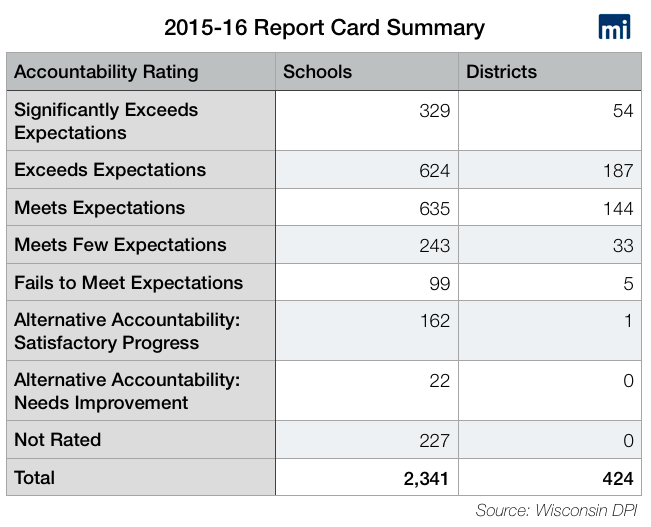
Report cards for the 2016-17 school year will be released in November. In addition to providing corrected graduation rates and new Forward Exam results, report cards grade individual schools and school districts using five different ratings, from “significantly exceeds expectations” to “fails to meet expectations.”
Just under 75 percent of the 2,341 schools in Wisconsin were scored as meeting expectations or better in 2016. Of the state’s 424 school districts, 91 percent were ranked as meeting expectations or better.

On the poor-performing side, 99 schools and five school districts qualified as failing. That means that approximately 52,000 students in Wisconsin attend failing schools. Given the incredible amount of state money we spend every year to educate our children, 52,000 students trapped in poor-performing schools is unacceptable. We must do better.
There’s also a certain irony that so many more students are in failing schools than students in districts considered failing. Just over 21,000 students attend the five failing school districts. There’s a clear disconnect with the fact that so many kids are trapped in districts considered to be meeting some expectations while their individual school is still failing.
Parents and taxpayers also need to examine whether these report cards are an accurate measure of success.
We’re still scratching our heads at the idea that MPS – which has nearly 25,000 students in failing schools – isn’t considered failing as a district while RUSD – which has nearly 10,000 students in the same situation – is. We call it Educrat Math.
Last year’s report cards also included data from the Forward Exam, administered in spring 2016 to 3rd-8th graders. That release of data showed that less than half of Wisconsin public school students are performing at grade level.
Of those tested with the Forward Exam, 42.5 percent of students were proficient in English and 42.3 percent were proficient in math. Students performed the “best” at science, with 50.1 percent achieving proficiency. Re-read that last number again. Just fifty percent was our best rating.
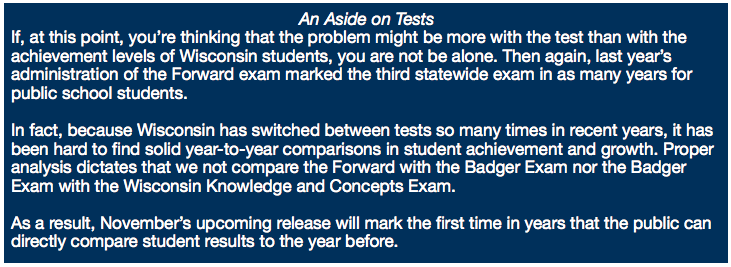
The report cards also highlighted extensive achievement gaps, a crucial issue for our students.
Achievement Gaps
From state exams, to the ACT, to the graduation rate, achievement gaps continue to persist between white students and minority groups. As the state’s minority population grows, this clear inequity will become more and more apparent, especially in places like MPS and the Metropolitan Madison School District (MMSD).
At MPS, the state’s largest district, students performed worse than the state average in every subject. On the Forward Exam, just 19.7 percent of MPS students achieved proficiency in English, and just 14.9 percent in math.

Within MPS itself, disparities between white and black students are clear. Achievement gaps between white and black students at MPS were smaller in every subject compared to the statewide averages, but both white and black students at MPS fared worse than the statewide averages for each race. In math, just 7.5 percent of black students at MPS were proficient, compared to 36 percent of white students. The 28.5 point gap is smaller than the state average of 39.3 for the same subject, but both numbers are alarming.
AP Courses and Exams
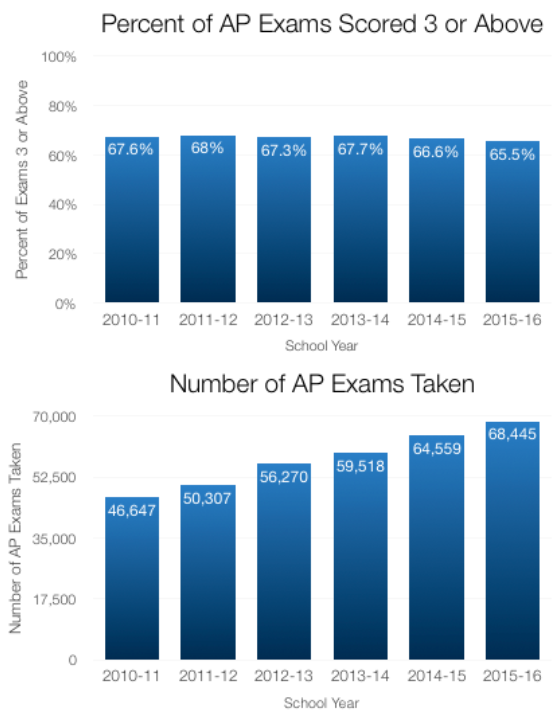
One positive trend that continued through the 2015-16 school year was a slow but steady growth in Advanced Placement (AP) exam participation, with 15.5 percent of students taking the exam in 2016.
AP classes are one of the best ways to prepare kids for their futures, whether or not they plan on going to college. AP classes teach students how to study in a different way than many of them have encountered before. If we’re talking college prep, AP exams are the name of the game (another is access to educational choice in a manner tailored to individual students, but more on that later).
Sixty-five percent of exam takers earned a three or higher, down from 66 percent in the previous year. Three credits typically mean that the student can earn college credit for having taken the exam. At UW System schools, for example, scores of three typically amount to three credits.
These credits can add up for students and translate to real money saved in their college careers. In some instances, high-achieving students can even graduate with a Bachelor’s Degree in three years with the credit earned from AP Exams alone.
Other Indicators of Student Success
School Choice in Wisconsin: Growth and Results
If you are the parent of one of the 20,000 children trapped in a failing school, there is good news for you in the 2017-2019 state budget. The budget committee has approved increasing the statewide school choice program’s income limits up to 220 percent of the federal poverty line, from 185 percent. This change will give more students access to a school of their choice and allow parents, not bureaucrats, to have more control over the education of their children.
It must be noted that Illinois recently adopted a school choice program with an income limit for families earning up to 300 percent of the poverty line. Illinois, more reform-minded than Wisconsin? We were surprised, too.
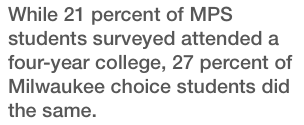
Meanwhile, students in choice schools tend to post better scores than their public education peers. And aside from the scores and educational assessments of different kinds, families themselves want options for schooling and continue to ask for greater access to choice. Waiting lists for the state’s parental choice programs continue to plague families across the state. For a parent waiting to get a child out of a failing school or a bad situation, it is incredibly frustrating that lawmakers don’t seem to understand the urgency.
One recent “study of studies” examined 22 major academic works on voucher schools. The findings for Milwaukee’s choice program were significant, showing a substantial impact on student graduation rates and college attainment.

Compared to their public school counterparts, choice students graduated high school and attended four-year colleges at higher rates. According to the report, the colleges also appeared to be of higher status. While 21 percent of MPS students surveyed attended a four-year college, 27 percent of Milwaukee choice students did the same.
Voucher students were also more likely to continue into their sophomore year of college, and parents were much more likely to report satisfaction with their child’s education.
They’re popular, too. By some estimates, 80 percent of students in Milwaukee practice a form of
choice. That ranges from students that attend their local traditional public schools to private school students, homeschooled students, students in charter institutions, and pupils that use open enrollment to attend a traditional public school that lies outside of their home district. Private schools, charter schools, and public school open enrollment are the state’s most popular form of school choice.

Student counts in terms of both open enrollment transfers and charter school attendance have all risen significantly despite a smaller total number of K-12 students in the state. Wisconsin’s families have chosen these schools over the past decade-plus and made these options a legitimate presence in the public school arena.
Another recent study by national research group Education Next surveyed parents of students at charter schools, traditional district schools, and private schools. From safety to teacher quality, in nearly every category, charter and private school parents reported greater satisfaction than traditional district schools.
Charter Schools
Independent charter schools will also see growth in the coming years. JFC’s budget allows charter schools to expand in any area of the state for the first time, rather than just in Madison and Milwaukee. The budget also increases the number of charter authorizers, allowing more UW chancellors and technical college boards to contract with charter school operators.
Charter schools made headlines in May when U.S. News and World Report declared Carmen High School – a public charter – to be the best school in the state. Bravo, Carmen.
Scores at Carmen are significantly higher than the surrounding areas, despite the fact that 87 percent of students are economically disadvantaged. A whopping 86 percent of Carmen students took an AP exam in 2016 – compare that to the statewide average of 15 percent and it’s easy to see how this school challenges students in a different way.
It’s important to note that charter schools are public schools, despite being a part of the school choice ecosystem. Simply put, their rules and regulations offer them a bit more flexibility than state law typically allows.
Enrollment Figures: K-12 and the University System
Statewide K-12 enrollment numbers continue to fall, continuing a trend in declining enrollment. In the 2016-17 school year, 863,881 students were enrolled in K-12 schools. The year prior, 867,137 students had been enrolled.
Meanwhile, state attendance and dropout rates have remained largely steady, though major gaps exist between districts.
Overall college attendance in Wisconsin, however, is rising over the long term.
In Fall 2016, 175,825 students attended the UW System. The year prior, 178,571 had been enrolled. Enrollment at the UW System has slowly fallen since 2010, but has still grown steadily over the long term. Most of those students attended the system’s flagship institute, the University of Wisconsin-Madison (go Badgers).
Remedial Education
Last fall, the MacIver Institute broke news on the state of remedial education in Wisconsin following the publication of a new report by the UW System.
If students make the decision to go to college, and then show up woefully unprepared, they have to take remedial courses at full cost but zero credit. Imagine paying $20,000 a year or more and receiving no college credit. It’s that bad.

That dataset showed that 175 high schools in Wisconsin had six or more 2015 graduates who needed remedial help in math or English as freshmen at the University of Wisconsin System.
The “Legislated Remedial Course Report” became a requirement after Rep. John Jagler (R-Watertown) discovered that 20 percent of all freshmen at the UW System require remedial help in math or English. UW could not tell him from which Wisconsin high schools these students came, and Jagler worked on a bill to bring the annual report into existence.
Since last year’s report, we are sorry to report that no major moves have been made on the important issue of remedial education in Wisconsin. There have been talks of increased collaboration between K-12 schools with the UW System to ensure that students arrive at college ready for success, but nothing game-changing has emerged.
This issue is particularly important for taxpayers. If students make the decision to go to college, and then show up woefully unprepared, they have to take remedial courses, again, at full cost but zero credit. We need our high schools to do a better job preparing our children for the rigors of college. It is a bad indicator that we have kids who are graduating from high school but are not ready to succeed at the next level.
In March, a national study showed that the University of Wisconsin-Milwaukee has a big problem with remediation and that it has a substantial affect on graduation rates. According to the study, just one in five black students graduated UW-M within six years.
Our children, our parents, our teachers and our schools – we must do better.
The (Potential?) Return of the OSPP
While the OSPP remains on hold for MPS students, all eyes are on RUSD as it hopes to avoid a “failing” designation for a second year in a row. That would, under normal circumstances, trigger the OSPP rules, starting with a new superintendent and a new plan for several turnaround schools.
You can catch up on the idea of the OSPP right here. In short, the idea is that districts that show no signs of improving would get a specially-appointed commissioner who could then pick several schools in which to implement a turnaround plan. If done correctly, it could be transformational for students who are stuck in these schools year after year.
One can easily compare the takeover-like requirement of the federal Every Student Succeeds Act to OSPP here in Wisconsin. While the same idea was called a “takeover” in Milwaukee, Obama’s law makes it a requirement for the state’s worst schools.
That’s right – the Obama-era law was more strict on failing schools than Wisconsin’s own school leaders would prefer.
RUSD officials appear to have gotten a major pass with a year-long exemption included in the Joint Finance K-12 budget. It may be good for the status quo, but Team MacIver is skeptical that it’ll ultimately be good for the students. Reform isn’t easy, but it’s important.
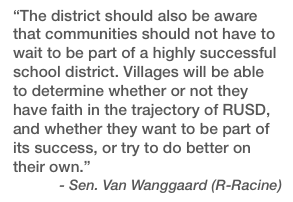
As it turns out, RUSD isn’t quite yet fully compliant with Act 10, that law you may have heard of that set off an entire recall attempt, saved taxpayers billions of dollars, and oh yeah – was passed way back in 2011. Once the budget goes into effect, the district will have 120 days to achieve compliance with the law and then prove to DPI that public unions are not collectively bargaining with school officials outside the law’s limitations.
If they achieve compliance in three months, they get the extra year before OSPP comes into effect. If the district again earns the “failing” designation from DPI, the villages within RUSD will have the option to hold a referendum on whether or not to split from RUSD. Of course, that wouldn’t be easy – smaller villages within the district have higher property values, but most don’t have their own school buildings. The budget includes funding to study the idea of splitting apart RUSD in the future.
Sen. Van Wanggaard (R-Racine) released a statement following the vote, writing that “in recognition of the changes that have been implemented since the last district report card, the budget allows the implementation of an OSPP to be delayed for one year. This is not a free pass, it is a possible one-year reprieve. RUSD must improve.”
Wanggaard went on to write in vaguely positive terms about the idea of a potential breaking apart of the district.
“The district should also be aware that communities should not have to wait to be part of a highly successful school district,” Wanggaard wrote. “Villages will be able to determine whether or not they have faith in the trajectory of RUSD, and whether they want to be part of its success, or try to do better on their own.”
A spokeswoman for RUSD thanked the Legislature for listening to the district’s request to delay the OSPP, pointing to recent reforms and improvements in student achievement, saying that the district is “confident these gains will be reflected in an improved report card this fall.”
At the same time, the statement took a hard swerve away from the notion of creating a new district, writing that RUSD has “serious concerns” with the idea and that the process would “cause severe turmoil, disruption, and overall extremely negatively impact our students, our families, and our entire community.”
We wonder about the honest impact a year-after-year 20.2 percent English proficiency rate has on students. How’s that for severe turmoil and disruption?
When the law was first passed, MPS was facing a four-year graduation rate of 58 percent. The latest data shows the district has improved slightly to 59.7 percent. While we can’t compare proficiency rates across years because of the change in tests, last year’s report card showed that 24,447 students attended 42 failing schools.
Of course, that was the same year that MPS as a district wasn’t considered failing, while RUSD was. In all, 9,605 students attended 11 failing RUSD schools. That could all change come November – will RUSD again be designated as failing? Will MPS slip back onto the failing list?
For now, we wait until November. Yet again, the kids will wait even longer.
—
That wraps up MacIver’s 2017 State of Education. We hope you found this roundup helpful and informative! Any issues we’re missing? Just drop a comment below.